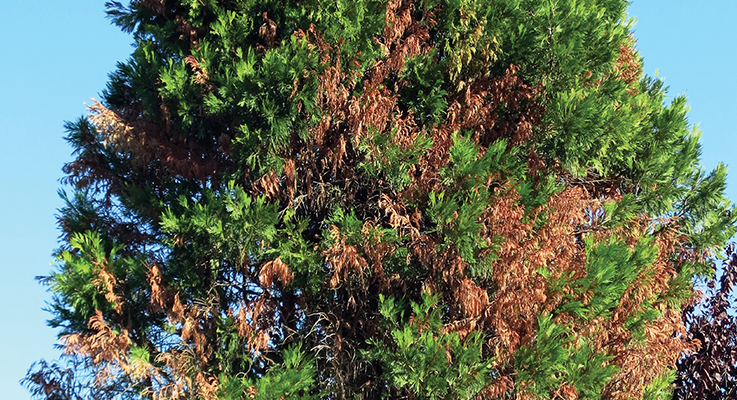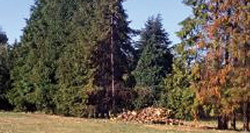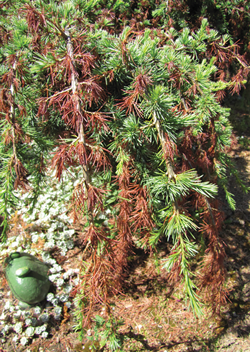Grower awareness of problems can protect both grower and customer

It’s important to be aware of issues in the landscape and forest, as they can become problems in the nursery or for your customers.
Cedar trees have a number of pest and problems to be aware of, from abiotic disorders to insects and diseases. Some problems may not be easily detected in the nursery. However, they still can become big issues when the trees are installed in the landscape.
The word cedar is used loosely on many different trees. We will cover problems on Cedrus spp. (true cedars), Chamaecyparis nootkatensis, Calocedrus decurrens (incense cedars), and Chamaecyparis lawsoniana (Port Orford cedars). We will cover Thuja spp. (arborvitae and western red cedars), junipers and cypresses in future issues.
Recently, drought has become a big issue, and the influence of drought on plant health can be very confusing. Many pathogens and insects respond to plant stress associated with drought, and it can be very difficult to discern which is truly responsible for the problem. Getting a proper identification of the pathogen or insect found on the plant allows the grower to determine if the pest is a drought opportunist or a primary host attacker.
Cedrus spp. (True cedars)
Needle blights have been found in many regions. The fungi Sirococcus spp. and Kabatina sp. have been associated with blighted needles of atlas (Cedrus atlantica) and deodar (Cedrus deodara) cedars. Sirococcus is found most often in the nursery as well as the landscape. The blight may be only on the needles or extend through the new shoot into the previous year’s growth. Terminal or lateral shoots may be blighted. Discolored tissue does not extend far into the branches. Shoot death and needle drop on established plants occur from June into August. Unfortunately, similar symptoms have been seen without the association of any fungi.
Armillaria root rot is another problem but mostly in the forest. It is not expected to be a nursery problem but could be in the landscape if trees are planted in new home sites recently cleared of native vegetation. Avoid wounding roots and overwatering in landscape settings.
Cedar flagging, the browning and loss of the oldest needles in mid to late summer, needlessly excites many people not familiar with this normal needle loss.
Chamaecyparis (current revisions suggest Callitropsis or Cupressus as the genus) nootkatensis (Alaska cedar or cypress, Nootka cedar or cypress, yellow cedar or cypress)
Drought injury has become a major issue over the last several years especially in the landscape as well as the forest. Although this problem can be observed in nature, it can also occur in potted nursery trees.
In some potted plants, the root-shoot ratio is so lopsided that trees have a difficult time maintaining water levels. Many conifers, including this cedar, are susceptible to drought stress especially when planted on lower elevation, south-facing or marginal sites.

Newly planted trees are most at risk to drought damage. Drought-stressed trees are highly susceptible to secondary attack from insects such as cedar bark beetles (Phloeosinus spp.) (Coleoptera: Curculionidae) and canker-causing fungi. Drought damage can accumulate over several years of subnormal precipitation and persist after normal conditions return. During extreme warm, dry weather, trees may not regenerate rootlets fast enough to replace those lost to moisture stress. The degenerating root system results in crown decline, which in turn reduces food supply to roots. This process is known as carbon starvation. Branch flagging may also indicate drought damage.
On the flip side is too much water saturating the soil in the root zone. This situation encourages Phytophthora root rots in the nursery and landscape. Although Alaska cedars are seldom killed by P. lateralis in the landscape, they are susceptible to other species such as P. cinnamomi.
Leyland cypress (intergeneric hybrid; Chamaecyparis nootkatensis and Cupressus macrocarpa)
Leyland cypress in the landscape is susceptible to drought problems at planting. Care in the first several years is often recommended to get them established. Since they are often planted as dense hedgerows they may become stressed from competition and intra-tree shading as they mature and experience drought. This can result in branch flagging and may be attacked by cedar bark beetles. Cedar bark beetles do not appear to be primary killers, but indicators of tree stress, especially drought.
As with other closely related genera, water saturating the soil in the root zone encourages Phytophthora root rots in the nursery and landscape.
The juniper scale (Carulaspis juniper) can be a problem in many locations. Symptoms of scale feeding include loss of normal color and luster of foliage, no new growth, and yellowing and death of branches. Severe infestations may kill entire trees. All members of the Cupressaceae family are attacked.
Calocedrus decurrens — incense cedar
Although incense cedar is considered more drought tolerant, it can still sustain injury when planted on lower elevation, south-facing or marginal sites. Trees weakened by drought and other stresses are more susceptible to branch canker.
Branch canker has become a major problem in Willamette Valley landscapes. Several fungi have been associated with cankers that result in substantial branch dieback. The disease progresses slowly up the tree resulting in significant branch loss over several years.

Although trees do not die from this disease, they are of much lower aesthetic value. Owners typically prune off the dead limbs each year, until only a few feet of living branches near the top remain. There is another unusual branch flagging/dieback that has been observed in Southern Oregon on incense cedar. A canker causing fungus is likely involved and recently tree mortality has been been observed.
Broom rust (Gymnosporangium libocedri) is a common problem wherever these trees are grown. This is the west coast version of cedar-apple rust (a different species not found here) you might read about east of the Rocky Mountains. The alternate hosts for broom rust are apple, crabapple, hawthorn, mountain ash, pear, quince and serviceberry (Amelanchier).
Infections on incense cedars in early spring produce spores in jelly-like orange masses (telia) during wet weather. Telia may produce spores over several weeks in the spring. The spores do not re-infect incense cedars, but are windblown to the deciduous host. On the deciduous host, leaf spots will be produced later in the spring. Spores produced on this host are windblown back to the incense cedars, where they initiate infections. After repeated infections, cedar trees eventually develop many shoots with shortened internodes at the ends of branches. This symptom is called a witches’ broom.
Not all brooms are due to rust fungi, and in Southern Oregon forests you might see incense cedar mistletoe (Phoradendron libocedri). Also in the forest and on older landscape tress, you might see pecky rot (Oligoporus amarus), a nasty heart rot of these trees that might be missed until hoof-shaped conks appear on the trunk. When conks appear, they indicate extensive decay inside the tree.
Cedar bark beetles have been commonly observed on dead trees in the forest and landscapes. They can be found on dead branches, tops, or trunks of declining trees. Although these beetles are secondary mortality agents, they are reported to become aggressive and kill healthy trees during drought. A mass attacked tree will have orange-red boring dust in the crevasses of the bark.
Chamaecyparis lawsoniana — Port Orford cedar
Root rots dominate the issues with Port Orford cedars. Phyptophthora root rot (Phyptophthora lateralis) is a familiar problem to nursery growers, landscapers and foresters. The disease was found in nursery stock in 1923 and has since spread throughout the Pacific Northwest, including into the trees’ native range.
Spread into the mountains of Southwestern Oregon has been slow but progressive. This water mold produces a swimming spore state that infects small roots first.
The organism moves into larger and larger roots until the tree is girdled near the root collar.
Infected inner bark turns cinnamon-brown in contrast to the normal cream color of healthy tissue. Infected trees’ foliage is a slightly lighter color and may wilt on warm days but then soon turns chlorotic, then bronze, and finally brown. Seedlings may die a few weeks after infection; large trees may take 2 to 4 years to die.
Resistant types are now available, including susceptible scions grafted onto resistant rootstocks. Armillaria root rot is another problem but mostly in the forest and landscape if trees are planted in new home sites recently cleared of native vegetation.
Cedar bark beetles are closely associated with decline and mortality from Phytophthora root rot in Port Orford cedar and it is generally thought that healthy trees are not susceptible to attack.
Stigmina blight (Pseudocercospora thujina) results in a common fungal blight in the landscape. Seedlings from parent trees located in watersheds in the southernmost, most inland areas, higher elevations, and lower annual precipitation had higher disease ratings. Seed stock collected from watersheds nearest to the coast, from more northern latitudes, and lower elevations developed less severe symptoms.
To get an accurate diagnosis of cedar problems, send your samples to the OSU Plant Clinic. For more information on diagnosis and management of these problems, please refer to the PNW Handbook for Insects and Plant Diseases. These can be found at the following site: https://pnwhandbooks.org/
Jay W. Pscheidt is an extension plant pathology specialist and professor of Botany and Plant Pathology with Oregon State University in Corvallis, Ore. He can be reached at [email protected].
David C. Shaw is a forestry and natural resources extension forest health specialist and professor of Forest Engineering, Resources, and Management with Oregon State University in Corvallis, he can be reached at [email protected].


